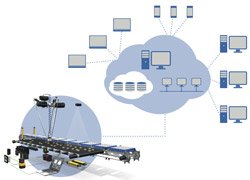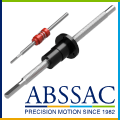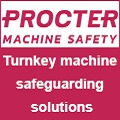
Posted to News on 8th Oct 2015, 17:43
Technology helps machine builders offer improved availability
With today's end users within the food and beverage industry highly focused on overall equipment effectiveness (OEE), Omron's Robert Brooks argues that there are real opportunities for machine builders to gain a competitive advantage by approaching a machine design with a similar focus on one of OEE's core threads, availability.

The ongoing pursuit of ever better OEE scores has become a real focus for end users in the food and beverage industry in recent years, and it is easy to see why. OEE's emphasis on the three key metrics of availability, performance and quality provides not just a benchmark against which they measure themselves against the best in the industry, but primarily a starting point for continuous improvement.
It is becoming increasingly common on the plant floor to see big screens overhanging each packaging line, displaying the productivity measures of each line for the day for all to see. Universally, end users find that such an approach significantly improves productivity. Operators become highly focused on the capabilities of their lines - indeed, beginning to metaphorically take ownership of those lines, looking for and suggesting areas for enhancement.
OEE itself, however, is not a conversation end users routinely have with their machinery suppliers, with the focus instead tending to be on areas such as baseline speed, cycle times and overall performance. However, if machine builders can bear OEE in mind during a machine design, and subsequently demonstrate how their machine designs can contribute to improved OEE results, then they can give themselves a significant competitive advantage.
One area where machine builders can really impact on OEE for the end user is in machine availability. For example, have you considered just how much money it costs when a machine fails, or while a machine is halted for a failed component replacement, or while a machine is stopped during a product changeover? This is not to say a machine is unreliable, but a machine's operational performance can be improved upon by using inherent capabilities in modern control system designs.
The inbuilt diagnostics and monitoring capabilities in today's automation equipment, such as Omron's Sysmac control platform, offer numerous opportunities for reducing or even all but eliminating unscheduled downtime. Inbuilt diagnostics can highlight developing problems before they become critical, enabling users to take preventative action during scheduled maintenance periods. These are systems that machine builders can easily build in as part of the machine design - without incurring additional costs, since these functions are generally part of the package with even the most modestly specified automation products.
Optimal move times
Consider, for example, the operation time of an actuator or cylinder. With a simple teach operation, the controller can learn the optimal move times in both directions, and limits can be expressed - creating rules perhaps for an early warning, and an alarm if the actuator's operation time falls outside of these rules, predicting a potential impending problem.
The same thinking could be applied to sensors on the production line. As installed, each sensor will have its ideal working conditions, but vibration can push it out of alignment, or a build-up of splatter from products could gradually impact on its operation. But the control system can monitor the sensor's performance, with limits set to trigger alarms as the output drifts towards tolerance limits. This again gives maintenance staff ample time to investigate the problem before it becomes a real issue.
The same could apply to monitoring servo torque values - knowing what the ideal should be, and setting alarms to spot if those torque values drift out of tolerance. A simple teach routine is all that is required in the first instance; the controller takes care of everything else from that point on. The machine controller can then flag up these warnings and alarms on an HMI local to the machine or inform engineers remotely of the issue, thus giving operators plenty of time to look at the operation of the devices in question and taking quick and appropriate actions before failures occur, avoiding unscheduled and costly downtime.
A further benefit to be derived from automation is being able to demonstrate to a customer, for example, how changeover times from one product size or packaging style to another could be significantly reduced.
"One push configuration' is now a standard feature in automation technologies such as Omron's Sysmac platform, principally because a whole range of products can be integrated over a single network protocol - Omron has standardised on EtherCAT as the ideal, high-speed machinery communications network - and programmed and set up from a single, unified software environment. This brings a single point of access to the configuration of the likes of servos, vision systems, sensors, temperature controllers, PLCs, drives and higher level databases.
Once the operator can configure the whole line from a single push button operation on an HMI, product changeover times are shortened. Thus, using an automation platform such as Sysmac, machine builders can demonstrate to end users how the downtime during product changeover can be minimised, getting the line back up and running much more quickly.
Minimising unscheduled downtime
Another area to consider is unscheduled downtime, and the cost implications that this has for the end user. It is a fact of life that mechanical components wear, environmentally delicate components such as sensors can gradually become coated in foodstuffs for example, and over time the performance of the machine can slowly degrade.
Today's automation equipment is inherently reliable, but even the most reliable of equipment can fail unexpectedly. If that faulty part is a complex piece of electrical equipment that may have incurred significant programming effort, then the end user could be facing substantial downtime. Mounting and cabling a new variable speed drive, for example, is nothing compared with the time taken to set it up and program its parameters.
Here machine builders can offer their end users the benefits of backup/restore functionality, perhaps with all the critical program settings and parameters stored on an SD card. Many Omron Sysmac components such as controllers and HMIs come equipped with SD card slots as standard, and even components which do not have SD card slots can have their settings saved to SD card via a networked HMI for example.
Potentially all of this could help an end user to get a machine back up and running without ever needing to call on engineering support from the machine builder. For the machine builder, that means an enhancement to your reputation for machines that are easy to maintain, but it also means that there is less need to take your own engineers away from important design projects and instead onto maintenance or support roles.
Importantly, none of the features which can help to increase machine availability have to be a challenge for the machine builder to implement. For example, Omron has addressed the requirements for teach activation, monitoring, pre-alarm warnings and alarms with a suite of new Function Blocks within the Sysmac control platform. This standard library of function blocks comes at no extra cost as part of the Sysmac Studio programming environment, and offers simple drag-and-drop usage.
Preventative maintenance
The technology ensures that the important information is delivered to the right person - either within the end user's maintenance team or with the machine builder's support personnel - at the right time, enabling the action to be taken in a timely fashion. That enables preventative maintenance during scheduled downtime rather than reactive maintenance during unscheduled downtime.
Further, the information gleaned from any impending fault alarms is not just of use to the end user in the moment; archived in higher level databases, it can provide useful trending information that can show how a machine performs over time, and can provide a basis for continuous improvement.
Armed with the capabilities of modern automation equipment such as the Sysmac platform, machine builders can design in as standard this ability to predict issues before they become real problems, to rectify faults quickly and efficiently, and to speed up product changeover times. In short, they have the ability to show end users how they can begin to boost availability and improve OEE results.
Follow the link for more information abut the Sysmac control platform from Omron.

































